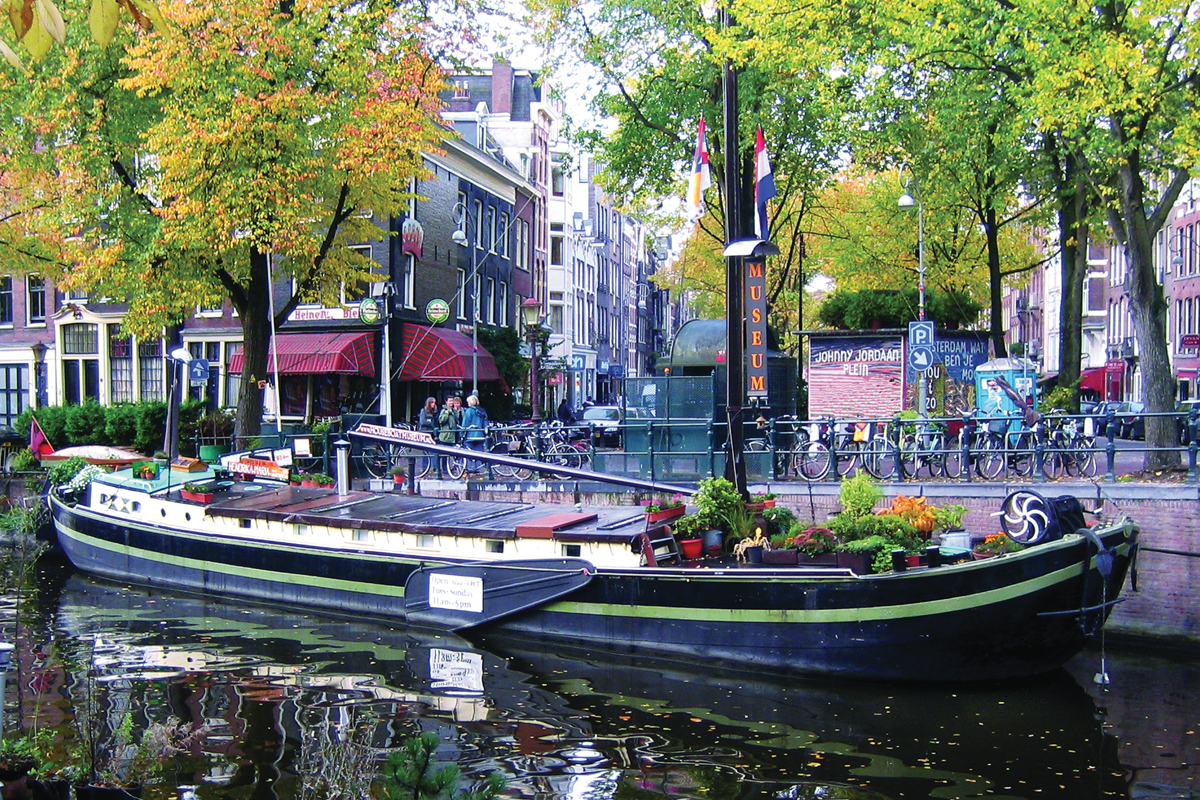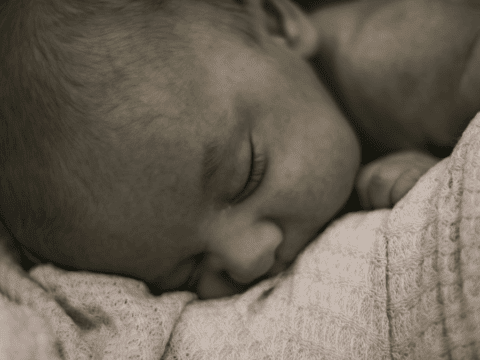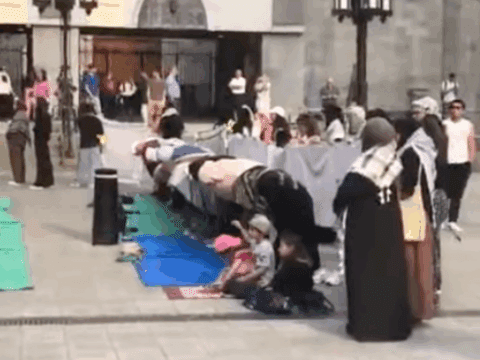The most important piece of art from my childhood was an 1866 Dutch print titled De Brede Weg en de Smalle Weg (The Broad and Narrow Way). It hung in my Oma and Opa’s dining room and was a vivid rendering of the contrast between worldly pleasures and virtuous living. I would stare at it for long periods of time, examining the two options.
On the one side was a humble uneven path dotted with a preacher’s tent, pilgrims carrying parcels on their backs, widows and children, a cross and a healing fountain, all leading to a golden palace encircled by 10 angels blowing trumpets.
You may unsubscribe from any of our newsletters at any time.
On the other side was an expansive paved street lined with a theatre, dance hall, pawnshop and lottery table. Beautifully dressed women carried parasols and glamorous couples danced in each other’s arms. A group of men raised glasses of ale at an outdoor patio. There were clear signs of trouble on this carnal course — the tiny image of a man hanging by his neck outside the pawnshop, someone pulling a knife on an unsuspecting traveller, an angry man whipping his donkey. In the far distance was a battle scene and, beyond that, a city engulfed in fire with bodies falling into the flames. Black angels circled ominously above.
I fixated on the two small bridges at the top of the picture that connected the paths, offering a last chance to cross from one side to the other, thus avoiding the fiery Armageddon. In my child’s mind I was already hedging my bets, calculating how I could experience a bit of the worldly life, then a quick right turn and, bingo, I’d be with the angels.
This picture epitomized my theological education as I scanned, Where’s Waldo-style, the dozens of characters in this moralizing tableau, all annotated with Bible verses in tiny type. In the Canadian Reformed Dutch community in which I grew up, it seemed the narrow way, which glorified suffering and simplicity, was the only way to salvation. All other roads led to hell.

My family was among the 150,000 immigrants to Canada from the Netherlands following the Second World War. A third were Catholic, a quarter from the Protestant state church (which recommended its emigrating members join the United Church) and a third were from the Reformed churches, which had their roots in the 16th-century Protestant Reformation and the teachings of theologian John Calvin, whose five principles are summarized in the TULIP acrostic: Total depravity, Unconditional election, Limited atonement, Irresistible grace and Perseverance of the saints. These Reformed churches built their own schools and churches and were reluctant to assimilate into the broader culture. My grandparents gave up life as they knew to cross the ocean on a 10-day journey to Canada aboard the Waterman, but then avoided mixing with Canadians, a word, when I was growing up, that was equivalent to “heathens.”
In the years after their immigration, the Netherlands became less religious and more permissive. My grandparents came to view their homeland as a country that had chosen the broad way. Today, the Netherlands is one of the least religious places in the world — 66 percent of its population of 17 million has no church affiliation. One in six clergy in the largest Protestant church are agnostic or atheist. Sliding religious practices corresponded with legalized cannabis cafés, red-light districts and a permissive attitude on everything from abortion to same-sex marriage and euthanasia.
But this apparent road to ruin doesn’t seem to have harmed the Dutch much. The Netherlands consistently ranks as one of the 10 happiest nations. Perhaps because their parents are so happy — and maybe because they get to eat hagelslag (chocolate sprinkles) on white bread for breakfast — Dutch children are happy too. UNICEF declares it the best place in the world to raise a child. There’s little violent crime, and its generous social benefits mean few homeless people. Post-secondary education is heavily subsidized. Its reputation for co-operation has been attributed to the population’s long struggle to work together to keep the sea at bay with dikes and dams (two-thirds of the country is vulnerable to flooding), living in extremely close quarters (it has one of the highest population densities in all of Europe) and communal suffering through five years of brutal Nazi occupation during the war.
While the Netherlands had progressed, its immigrants from the Reformed community (who today number 102,800 of one million Dutch descendants in Canada) seemed stuck in the past. The Dutch may have been famous for their pragmatic tolerance, but I didn’t see much of that in the restrictive religion in which I was raised. Life revolved around private Christian school and church life — services twice on Sunday, catechism on Wednesdays, Young People’s on Friday. Union membership was verboten. Some refused to buy insurance because it was seen as an attempt to defy God, upon whom you were expected to rely for your wellbeing. Any variation from the norm was suspect. When I wore pants on the first day of Grade 7 (in a school named after John Calvin) I was called out by the minister. “What? Do you want to be a boy?” he chided. This was the same minister who told my mother in her early 20s that, according to biblical teaching, she would be committing adultery and going to hell if she ever remarried after my father deserted our family.
To be sure, there were things I loved about being Dutch. Much of it centred around treats: chocolate letters at Christmas, oliebollen (a deep fried pastry rolled in icing sugar) at New Year’s and zoute drops (salty liquorice) passed around during interminably long sermons. I remember the feeling of comfort and security as a child when I sat on my Oma’s lap, listening to her mellifluous voice praying in Dutch after Sunday night dinners. My father had left our family when I was three, but for a long time I lived with the certainty that there was a loving ever-present father figure in heaven personally looking out for me.
Despite my Dutch descent, my imaginings of the Netherlands were as trite as any tourist’s: fields of tulips, iconic windmills, canals framed by picturesque bridges, farmers in wooden clogs and squeaky clean front windows edged with white lace curtains.
At 53, I visited the old country. The Netherlands was not my home but it was my history.
Within minutes of getting off a KLM plane at Amsterdam’s Schiphol airport last November, I was on a train to Rotterdam and got my first glimpse of a windmill, standing stately in a foggy bog, looking very much like the one in the dark painting that had hung over the velour couch of my grandparents’ home in Canada.
There was much that was immediately familiar, from the Dutch language (described as sounding like a drunk gargling soup) to the enthusiastic extroversion of everyone from market stall vendors to museum goers as well as the beanstalk proportions of its citizens (the men average six feet and the women 5-7), generally attributed to a dairy-stuffed diet of gouda and cow’s milk.
Rotterdam, a city architecturally reinvented after being decimated by bombs during the war, was my first stop in a weeklong three-city tour. The dramatic, swooping cable-stayed Erasmus Bridge over the Maas River epitomizes the Dutch determination to rise from the ashes. Rotterdam is also known for boundary-pushing public art, such as the sculpture of Santa Claus holding what may be a Christmas tree but is shaped more like a sex toy — a commentary on the fetishization of Christmas. My sudden burst of laughter on seeing this curious artwork attracted the attention of an older Dutchman who approached me, red faced, to practically shout, “It’s obscene!” I have no doubt my grandparents would have fully agreed.
Next, I travelled north to Groningen, known as the bike capital of the world, thanks in great part to politician Max van den Berg, who convinced city hall to practically expel cars in favour of bikes in the city centre back in the 1970s. I hop on a bicycle for a ride around the city and think of my quiet, contemplative grandfather, who used to cycle near here, travelling 35 kilometres each way to visit my grandmother when they were courting.
On impulse, I take an early morning taxi ride to Roden, Drenthe, where they lived before emigrating. Entering the town, I see clusters of bicycle lights emerging from the predawn darkness like choreographed fireflies as groups of riders weave smoothly around each other heading to work. After a visit to Holland in 1935, Virginia Woolf described this swarm-like behaviour in her diary: “The cyclists go in flocks like starlings, gathering together, skimming in and out.” In Roden, I find the old plain brick church my grandparents likely attended and I walk through a cemetery where I see many familiar names, although none from my family. I pass lots of house barns (structures that ensured the body heat of animals would help warm the humans’ living quarters) that look exactly like the one in the black and white photo my Oma kept in a leather album. That night, I dream about sitting on my Oma’s lap after Sunday dinner, a habit of mine until I reached 12 and got too tall and gangly and reluctantly stopped.
Before visiting the Netherlands, I didn’t understand much about its historic division between the rural Protestant north and the liberal Catholic south. Catholic Spanish kings once fiercely ruled the country and, until the Reformation, anyone found in possession of a Protestant Bible could be condemned to death. Thousands were executed for their beliefs. This long ago animosity was kept alive in my family in the contempt and inexplicable myths expressed about Catholics. “They worship in round churches because they’re afraid of the devil getting in the corner,” my Oma told me. No wonder I was a nervous wreck when I introduced the Catholic-raised man I was about to marry (now my husband of 30 years) to my kin and a family member told him, “You know, you Catholics used to burn us at the stake.” He apologized and, later, I apologized to him.
Within the Reformed religions themselves, longstanding conflicts around obscure points of church doctrine have resulted in breakups. The Dutch Reformed brought their religious rivalries with them to Canada. Today, the Christian Reformed Church numbers around 65,400 members while the other 37,400 are dispersed among another half-dozen splinter groups. There’s a well-known saying: “One Dutchman is a theologian, two are a church and three are a schism.”
My final stop is Amsterdam. Tourists are titillated by its red-light district and coffee bars where the air is thick with marijuana smoke, but I forgo taking more than a cursory peek at the pot shops and prostitutes in favour of zipping through some of its 50 museums. Ever since I was 11 and read The Diary of a Young Girl, in which Anne Frank documents daily life in secret attic rooms before she and her family were discovered and sent to concentration camps, I have wanted to see where she lived. Pencil marks on the wall indicate the growth of Anne and her sister Margot over the course of two years. On the wall above her bed are magazine pictures of Greta Garbo and Ginger Rogers.
In a video, her father, Otto Frank, the family’s only survivor, says the museum is important because “to build a future you have to know the past.” He says he was surprised by the deep thoughts Anne expressed in her dairy. “My conclusion . . . is most parents don’t really know their children.”
Children often don’t express their private thoughts because they worry about disappointing their parents. That was certainly true for me. I wanted to leave the church I grew up in but was afraid of letting my family down. When I was 20, I made the final break. Church elders sent me a letter telling me my soul was “barred from the gates of heaven.” My mother was in despair, and so was I, for breaking her heart.
I floundered spiritually for years until my early 30s, when, struggling with the turmoil of religious strife in my family, I phoned a local United Church and connected with Rev. Harry Oussoren. As it happened, he too was from a Dutch Reformed background. He listened, reassured and offered some measure of peace. Two years later, he baptized my first daughter and I found a happy church home for a decade in the United Church and an uneasy truce with my family. I eventually landed in the Unitarian church, which my family found harder to accept. I had found my spiritual home, but the cost was no longer feeling accepted in my childhood home.
The Van Gogh Museum in Amsterdam is my final stop. I marvel over the famous Irises and Wheatfield with Crows and then see something new to me: Still Life with Bible, depicting a large black Bible with a small weathered copy of Emile Zola’s La joie de vivre in the foreground. To Vincent van Gogh, the Bible represented looking backward while modern works like Zola’s looked forward.
A Google search revealed van Gogh had a turbulent relationship with his father, a pastor in the Dutch Reformed Church. In 1883, van Gogh wrote to his brother, Theo: “I feel what Father and Mother think of me instinctively . . . the same dread of taking me in the house as they would about taking in a big, rough dog. . . . He will be in everybody’s way. And he barks so loud. In short, he is a foul beast. All right — but the beast has a human history, and though only a dog, he has a human soul, and even a very sensitive one, that makes him feel what people think of him. . . . And I, admitting that I am a kind of dog, leave them alone.”
I stare at the painting a long time, considering the artist’s status as an outcast, his estrangement from his family, the comfort he found in secular prose and the long shadow cast by that big Bible.
It resonates more deeply than De Brede Weg en de Smalle Weg ever did. But today that old Dutch print hangs in my home, an inheritance from my grandparents. I have a different take on it now. Yes, it is good when faith is humble and heartfelt and yes, life can present plenty of suffering as depicted on that narrow way. But I have no quarrel with the spirited life of the dancehall. I keep this picture to honour the memory of my grandparents, Luink and Anna Luinge. And also to honour the courage they had to take that long ago overseas journey that landed me here today.
Anne Bokma travelled to Holland as a guest of the Netherlands Board of Tourism.














